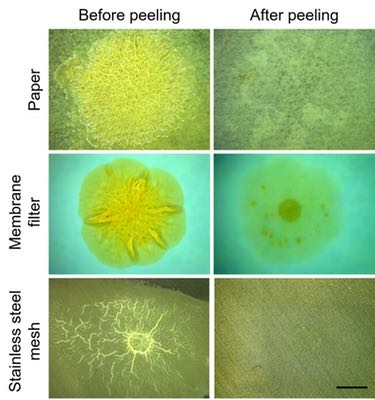Researchers at Princeton have found a way to cleanly and completely remove biofilms, called capillary peeling. By looking at the films from a mechanical engineering perspective, as well as a biological one, the researchers showed that water penetrating the junction between biofilms and surfaces, coupled with gentle peeling, can result in immaculate removals.
Capillary peeling seems to result in an improved outcome over the traditionally ineffective methods of scraping or mechanically dislodging biofilms, which sometimes leave behind still-adhered patches that can regrow and re-contaminate.
The new removal method, published in Advanced Materials, should help in thwarting harmful biofilms, as well as controlling the beneficial biofilms increasingly relied on for wastewater treatment, microbial fuel cells and other applications.
"By investigating and defining the material properties of bacterial biofilms, rather than their biological properties, we have invented a new method for detaching entire biofilms," said study co-author Bonnie Bassler, the Squibb Professor of Molecular Biology at Princeton and Howard Hughes Medical Institute Investigator.
How it works
For their investigation, the researchers turned to the bacterium Vibrio cholerae, which forms biofilms in seawater, freshwater and the human intestine. Measurements revealed that the biofilms it produces exhibit mechanical behaviours very similar to hydrogels.

Biofilm images, before and after capillary peeling
Well-characterised, manipulatable hydrogels have many applications, especially in biomedicine, including wound dressing, drug delivery and tissue engineering. Both biofilms and hydrogels are largely made of water (about 90%). They possess defined structural networks that make them soft, viscous and elastic.
Their stretchiness has a limit, however. If disturbed too vigorously, biofilms and hydrogels will break into pieces. This fragility poses a challenge for biofilm removal. It also hinders the intentional transfer of beneficial films between surfaces, for instance in industrial settings, and when running experiments in the lab to better understand biofilms in the first place.
To learn how to avoid such fragmentation, the Princeton team examined the attachment of the V. cholerae biofilms to a variety of surface types. The researchers saw that the edges of the biofilms were water repellant, while surfaces they adhered to were sometimes water-attractive. Based on this insight, the researchers sought to drive a wedge between the biofilm and attached surface by driving water into the space at which the materials meet.
This technique, known as capillary peeling, successfully created a lengthening crack that culminated in full separation of the biofilm from the surface. The water-assisted peeling must go slowly to prevent biofilm tears —akin to carefully removing a sticker— but the results showed that the extra time was well worth it.
Underwater targets
One obstacle for deploying the method outside the lab is that many biofilms exist in already-aqueous environments, where capillary peeling would appear to be a non-starter. For those cases, the research team proposed two potential solutions to explore in future research.
For biofilms initially grown underwater, the film and its adhered-to object could be removed from solution and dried out before removal attempts. Alternatively, introducing bubbles to the biofilm-substrate interface might deliver the same sort of capillary force.
Overall, the new study illustrates the value of a multidisciplinary approach, bridging different fields to make key new insights.
Princeton's Howard Stone echoes Rubinstein's observation that the study's results and promise of real-world applications spring from a nexus of disciplines.
"Led by Jing, the students and postdocs did amazing work in developing a detailed understanding of the link between the biological components and the macroscopic mechanical properties of biofilms," said Stone.
He concluded: "Our demonstration that biofilms can be peeled —intact— may prove useful in a multitude of ways going forward."
